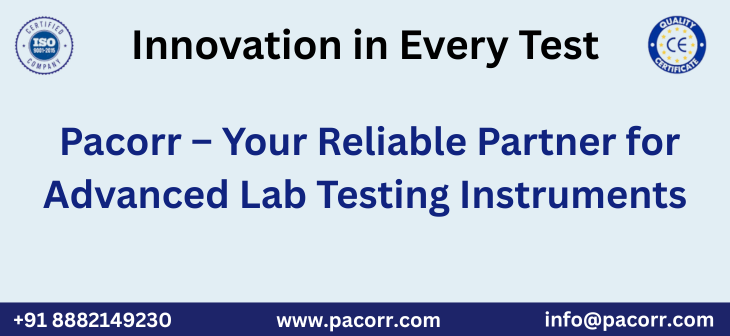
In today’s competitive packaging and logistics landscape, Pacorr stands out as a reliable manufacturer of precision-engineered testing instruments. Among its top-tier offerings, Vibration Tables play a critical role in evaluating the durability and performance of packaged goods during simulated transport conditions. Whether a product is shipped by road, rail, air, or sea, it experiences a range of vibrational forces that can damage its packaging or compromise its contents. That’s where Pacorr’s Vibration Testing Tables specifically mechanical vibration tables and pneumatic vibration tables—prove to be indispensable tools for quality control professionals.
This blog provides a comprehensive comparison of mechanical and pneumatic vibration tables, discussing how each operates, their respective advantages, and where they are best suited for industrial applications.
What is a Vibration Table and Why is It Important
A Vibration Table is a testing machine used to simulate the vibrational stress a product experiences during handling and transportation. This helps manufacturers assess the strength, integrity, and packaging design of their goods under real-world transport conditions. It is particularly vital in industries such as electronics, consumer goods, pharmaceuticals, and automotive.
Pacorr’s Vibration Tables are known for their robust construction, consistent performance, and compliance with major testing standards like ASTM D999, ISTA series, and ISO 2247.
Mechanical Vibration Tables: Working Principle and Features
Mechanical Vibration Tables from Pacorr operate using an eccentric cam mechanism powered by an electric motor. The motor drives the camshaft, converting rotary motion into linear reciprocating motion. This generates a consistent and repetitive vertical or horizontal movement across the platform surface.
Key Features of Mechanical Vibration Tables
- Fixed Frequency Output: Usually provides vibration at standard frequencies, often set to around 60 Hz or customized as required.
- Motor-Driven Cam System: Mechanically simple, reliable, and cost-effective.
- Durable Construction: Ideal for heavy-duty usage and longer operational life.
- Low Maintenance: Fewer moving parts result in less wear and reduced servicing needs.
Best Suited For
- Testing smaller to medium-sized packages.
- Applications where vibration frequency requirements are standard and consistent.
- Environments where compressed air supply is unavailable or limited.
Pneumatic Vibration Tables: Working Principle and Features
Pneumatic Vibration Tables, on the other hand, operate using compressed air or gas to create the vibrational motion. They incorporate air cylinders or pneumatic actuators to produce linear motion, which results in highly controllable vibrations.
Key Features of Pneumatic Vibration Tables
- Variable Frequency and Amplitude: Operators can fine-tune settings as per test conditions or standards.
- Smooth and Quiet Operation: Ideal for lab environments where noise needs to be minimized.
- Gentler Force Distribution: Reduces wear on delicate items during testing.
- Highly Customizable: Easily integrated into automated testing systems.
Best Suited For
- Fragile or sensitive goods like electronics or medical equipment.
- Complex packaging structures requiring dynamic test profiles.
- Industries with an existing compressed air infrastructure.
Factors to Consider When Choosing Between Mechanical and Pneumatic Vibration Tables
When selecting the right Pacorr Vibration Table for your testing requirements, it is essential to evaluate a few critical factors:
1. Product Sensitivity
If you are testing fragile items like glassware, electronics, or medical instruments, pneumatic tables offer the advantage of fine-tuned, gentler vibration, reducing the risk of unintended damage.
2. Required Test Parameters
If your testing protocols require varying frequencies and amplitudes (for example, ISTA 3A profiles), pneumatic tables provide greater flexibility. For basic, repetitive tests, mechanical tables are sufficient and economical.
3. Infrastructure Availability
Mechanical vibration tables only need electrical power, while pneumatic systems require a reliable compressed air supply. Consider the existing setup in your facility.
4. Budget and Maintenance
Mechanical models have lower acquisition and maintenance costs. Pneumatic models may cost more upfront but offer long-term value in high-precision or automated testing lines.
Industry Applications of Pacorr’s Vibration Tables
Pacorr Mechanical and Pneumatic Vibration Tables are used in a wide variety of industries, each benefiting from tailored simulation testing:
- Automotive: Validating packaging for auto parts, batteries, and glass panels.
- Electronics: Testing protective packaging for consumer electronics and circuit boards.
- FMCG: Ensuring that cosmetics, food containers, and beverages reach retailers intact.
- Pharmaceutical: Simulating transport conditions for vaccines, syringes, and glass vials.
Both types of tables help manufacturers comply with transport simulation standards, reducing field failure rates and improving customer satisfaction.
Why Choose Pacorr for Vibration Testing Solutions
Pacorr has extensive experience in the design and development of transport simulation equipment, with a focus on reliability, accuracy, and user-friendly interfaces. Whether your requirement is for mechanical vibration tables or pneumatic vibration testing equipment, Pacorr delivers high-performance solutions tailored to your application.
What sets Pacorr apart is their commitment to customization, after-sales support, and compliance with international testing standards, which makes them a trusted partner in the quality assurance ecosystem.
Conclusion
Both mechanical and pneumatic vibration tables have unique advantages depending on the testing requirements, industry applications, and budget constraints. Pacorr, as a leader in testing equipment manufacturing, offers reliable and robust solutions in both categories, helping businesses ensure the safety and integrity of their packaged goods during shipping and handling.
Understanding the difference between mechanical and pneumatic vibration tables helps you make an informed decision that aligns with your product’s needs, testing goals, and operational setup. Investing in the right type of vibration table from Pacorr not only enhances product reliability but also boosts customer confidence in your brand.
FAQ Section
Q1. What is the main difference between a mechanical and a pneumatic vibration table?
A mechanical vibration table operates using a motor-driven camshaft, offering fixed frequency output. A pneumatic vibration table uses compressed air and provides variable frequency and smoother vibrations.
Q2. Which industries use pneumatic vibration tables?
Industries like electronics, pharmaceuticals, and aerospace use pneumatic vibration tables due to their precise control and gentle handling of sensitive products.
Q3. Are mechanical vibration tables suitable for fragile items?
They can be used for basic packaging but may not be ideal for very delicate products due to limited control over amplitude and frequency.
Q4. Does Pacorr provide both mechanical and pneumatic models?
Yes, Pacorr offers both mechanical and pneumatic vibration tables designed to meet varied industrial testing requirements.
Q5. What standards do Pacorr vibration tables comply with?
Pacorr vibration tables comply with major global standards such as ASTM D999, ISTA 1A/2A/3A, ISO 2247, and ISO 13355.
Thanks to Pacorr Testing instruments, we have all the required quality testing instruments that have helped us to ensure the best quality delivered to our clients.

Danish
Fair Exports Pvt. Ltd.

